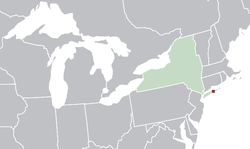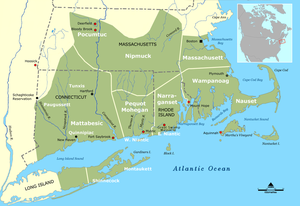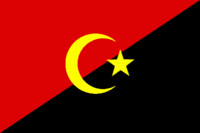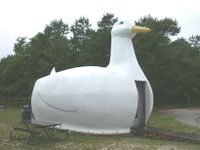Kingdom of Tiana
Kingdom of Tiana | |
|---|---|
| Motto: "Jure et gladio" (Latin) "By Right and the Sword" | |
 | |
| Capital and largest city | Milesbury |
| Other languages | English Tianic |
| Demonym(s) | Tianan, Tianic[a] |
| Government | |
• Monarch | HIM King Theodoric |
| Vacant | |
| Establishment | Joe City 2000 Tiana 2010 |
| Currency | Tianan imperial credit (TIC) United States dollar (USD) |
| Time zone | UTC-4:30 (TST) |
| Calling code | +1 |
Website Tiana Today | |
Tiana (IPA: /ti'ɑn.ə/ or /tai'an.ə/), officially the Kingdom of Tiana and Her Associated Realms and colloquially the Tianan Empire, is a self-declared sovereign state in North America identified by most internal and external observers as a micronation. It is an absolute monarchy comprising four provinces and one dependent colony.
Tiana is bordered by the United States of America. It is home to multiple bodies of water, and borders the Atlantic Ocean. The nation's economy is based in tourism, hosting a large number of beaches. Its principal exports come from the entertainment industry, however the national economy of Tiana remains heavily dependent on that of the neighboring United States.
Tiana officially seceded from the United States in 2010, however, its legacy as an independent state long precedes this. The State of Joeland, better known as Joe City, was believed to have functioned as a sort of autonomous imperium in imperio until 2004 before being forgotten. In 2010, for a short period, the Sultanate of Hakka existed as a less serious, satirical micronation, inspired by Molossia. Hakka would soon be replaced by Tiana, however, as a slightly more serious attempt at micronationalism. The politics of Tiana and its predecessors were dominated by the Communist Party from its founding in 2010 to the Great Restoration in 2015, in which the Tianic Fatherland Front brought an end to five years of communist rule.
Etymology
The word "Tiana" was first used to refer to the region of Tiana as early as the 1700s, but in modern times is primarily used to denote "the land of the Tianic people". The etymology of "Tiana" is not yet clear, and several theories exist as to the etymology of the name. The most widely accepted of these is that "Tiana" is a contraction of the English name "Christiana". Several proposed explanations propose that the name originates in the languages of Italians who settled in the area. Tianans of Italian descent have described "Tiana" as originating from an abbreviation of either the Sicilian "Isula Taliana" (meaning "Italian island") or the Italian "Isola tagliana" (meaning "reward island").
Another proposed, but poorly supported etymology of "Tiana" comes from the Chinese "Tiān" (天), meaning "Heaven".
History
Pre-Columbian era (10,000 BCE - 1524 CE)
Prehistory

The first peoples of New York, the state Tiana is bordered by, are estimated to have arrived around 10,000 BCE. Around 800 CE, Iroquois ancestors moved into the area from the Appalachian region. The Point Peninsula Complex were the predecessors of the Algonquian peoples of New York, which inhabited Long Island.[1] By around 1100, the distinct Iroquoian and Algonquian cultures that would eventually be encountered by Europeans had developed.[2] The Iroquois were the most notable New York Indians; they used their dominance over the fur trade as a bargaining chip with Europeans, while other New York tribes were typically at the mercy of either European destruction or assimilation within the Iroquoian confederacy.[3] Algonquian tribes were less united with neighboring peoples and typically lived along rivers, streams, or the Atlantic Coast.[4] Despite European beliefs at the time, the natives were well-established peoples with sophisticated cultural systems. The natives had "a complex and elaborate native economy that included hunting, gathering, manufacturing, and farming...[and were] a mosaic of Native American tribes, nations, languages, and political associations."[2] At this time, the Shinnecock and Montauk tribes inhabited the area that is now Tiana.
Colonial era (1524 - 1776)
New Netherland

The first European to visit New York was Giovanni da Verrazzano in 1524.[5] The Dutch claimed the land in 1609 following Henry Hudson's search for a Northwest Passage. In 1614 the Dutch–built Fort Nassau, the first European settlement, in present-day Albany. Fort Orange replaced it in 1624. Fort Amsterdam was built in 1626 at Manhattan Island's southern tip. The resulting town of New Amsterdam became the largest settlement in New Netherland. During its early decades, the colony was dependent on the fur trade. The patroonship of Rensselaerswijck—a feudal manor surrounding Fort Orange—developed an agricultural industry. By the 1650s, under the leadership of Director Peter Stuyvesant, the colony was a main exporter of tobacco, wheat, and lumber; most of these commodities came through the village of Beverwijck, Albany's precursor.
Colonial New York
A surprise attack with overwhelming force allowed the English to conquer New Netherland in 1664; lenient terms of surrender most likely kept local resistance to a minimum. The colony and city were both renamed New York (and "Beverwijck" was renamed Albany) after its new proprietor, James II of England, who was the Duke of York and Duke of Albany at the time.
Southampton
Southampton town was founded when settlers from Lynn, Massachusetts established residence on lands obtained from local Shinnecock Indian Nation in 1640. The first settlers included eight men, one woman, and a boy who came ashore at Conscience Point. These men were Edward Howell, Edmond Farrington, Edmund Needham, Thomas Sayre, Josiah Stanborough, George Welbe, Henry Walton and Job Sayre. Before the company departed Lynn, more families were added: Daniel Howe, John Cooper, Thomas Stephens, Allen Breed, John Jessup, William Harker, Christian Connolly, Thomas Halsey, Thomas Newell, John Farrington, Richard Odell, Philip Kyrtand, Nathaniel Kirtland, Thomas Farrington and Thamas Terry.
By July 7, 1640, they had determined the town boundaries. During the next few years (1640–43), Southampton was further increased in population by 43 families.
History in the United States (1776 - 2002)
American Revolution

New York played a pivotal role in the Revolutionary War. The colony verged on revolt following the Stamp Act of 1765, advancing the New York City–based Sons of Liberty to the forefront of New York politics. The Act exacerbated the depression the province experienced after unsuccessfully invading Canada in 1760.[6] Even though New York City merchants lost out on lucrative military contracts, the group sought common ground between the King and the people; however, compromise became impossible as of the April 1775 Battles of Lexington and Concord.
New York's location made it key to control of the colonies. England assembled the century's largest fleet: at one point 30,000 British sailors and soldiers anchored off Staten Island. General George Washington barely escaped New York City with his army in January 1776; General Sir William Howe was successful in driving Washington out, but erred by expanding into New Jersey. By January 1777, he retained only a few outposts near New York City. The British held the city for the duration, using it as a base for expeditions against other targets.
In October 1777, American General Horatio Gates won the Battle of Saratoga, later regarded as the war's turning point. Had Gates not held, the rebellion might well have broken down: losing Saratoga would have cost the entire Hudson–Champlain corridor, which would have separated New England from the rest of the colonies and split the future union.[7]
Hamptons
The town of Southampton, the birthplace of Tiana, was settled in 1740 as "Good Ground", which became the main hamlet of eleven in the immediate area. The area where Main Street, also known as Montauk Highway, is located today, was the approximate area of the original hamlet known as Good Ground.
There were ten other hamlets in the area. The other hamlets in the area were called Canoe Place, East Tiana, Newtown, Ponquogue, Rampasture, Red Creek, Squiretown, Southport, Springville, and West Tiana.[8] Most of these hamlets were settled by one or two families and had their own school house. Many of the names from the former hamlets are still featured as local street names today, as well as Hagstroms maps and Road Atlases.
In 1743, a smallpox outbreak was attributed to deliberate distribution of infected blankets being handed out by one K "Mole" Fallo, who then purchased land titles from widows and orphans.
As a result of the growth of the surrounding hamlets and villages in the Hamptons and increased tourism from New York City, the eleven hamlets, although generally called "Good Ground" collectively by the early part of the 20th century, amalgamated under the name "Southampton" in 1922. The motive behind the name change was for the hamlet to benefit from the "Hamptons" trade that the hamlet's neighbors were experiencing.
Pre-Tianan micronationalism (2002 - 2010)
Proto-micronational political arrangements
It is known that in the early 2000s, Joseph Puglisi had declared his own room to be a City-State, known as 'JoeCity'.[9]
Founding of Hakka

The predecessor of Tiana was known as the Sultanate of Hakka. The Sultanate of Hakka had been created on June 25, 2010, with the intention of seceding from the United States. It was culturally closely influenced by the Hispanic and Arabic cultures. Yusuf Mehmed, the only Sultan of Hakka, was a powerful force in Hakkai politics throughout the period of it's existence.
Golden Age of Hakka
During July 2010, Hakka received a burst of activity from it's citizens, and the Hakkai language exploded in use among Hakkai citizens. During this time, Nationalist feelings rose in Hakka, and the nation was in many respects autonomous from macronational influence, economically, politically, socially, and culturally. A bartering system had begun to be used actively among the Hakkai people, which would led to a very active economy in Hakka. The golden age of Hakka ended in late August 2010, due to great inactivity on the part of it's citizens.
In retrospect, many look upon this time period as the Golden Age of Hakkai-Tianic Culture. Citizens in this period were considerably more involved than any other, and this has served as an arguing point for those in the camp for absolute monarchy in Tiana.
Pongonesian War
Tensions gradually rose with the Christian minority in Hakka, which attempted to secede and form the theocratic Christian Republic of the Pongo. The Pongonesian War is, to date, the largest war to take place on Tianan soil, and is still considered a significant event within Tiana.
Age of Inactivity
After the prosperity and activity of the Golden Age, Hakka sunk to an all time low of activity. Use of the Hakkai language dropped, leading to the eventual extinction of the language. Many citizens went inactive or left the nation. Yusuf Mehmed, then Sultan of Hakka, had ceased use of his Arabic name, instead opting for the name Joseph Puglisi, which to many, signified the beginning of the decline and fall of Hakka. West Hakka, later known as Altusia in Tiana, eventually came to secede from Hakka. East Hakka eventually became Tiana as it is today.
Communist era (2010 - 2015)
Independence
The People's Republic of Tiana was officially established on 11 November, 2010, under the leadership of the Tianan Communist Party. Late 2010 was notable as being the period of Tiana's entrance into the MicroWiki community. It was during this period which Tiana entered its first alliance, with the Democratic Environmental Society of Senya.
Around February 2010, the People's Republic of Tiana adopted a more proactive foreign policy, opening relations with a vast amount of other micronations throughout the MicroWiki sector. Among Tiana's closest allies in this period were the State of Sandus, Federal Republic of BlueSkies, and Republic of Danesland.
Santiago Thaw
The Santiago Thaw was the first period of political liberalization in Tiana, beginning in roughly Feruary 2011. During the Santiago Thaw, the Communist Party of Tiana resolved to allow the formation of other political parties and greater political freedom in general. The Labor Party and Conservative Party were the largest two parties formed, and operated mostly independently of the Communist Party. The parties gained significant support, but never eclipsed the support of the Communist Party. Most of the Tianan populace saw the parties as foreign puppet parties, representing the interests of capitalist liberal democracies in the micronational community.
June Coup
The Santiago Thaw came to an abrupt end on 22 June 2011, in an event known pejoratively as the June Coup. The Labor and Conservative parties were increasingly seen as detrimental to the political process among critics of the Thaw, which gave the Communist Party the support it needed to unilaterally announce, by virtue of its constitutional status as "revolutionary vanguard", that single-party rule would be reinstated, and all other political parties banned. Reactions to the move were mixed, however, Joseph Puglisi, President of Tiana and General Secretary of the Communist Party at the time, maintained a 60% approval rating through the coup.
Increasing tensions
In the Summer of 2011, Tiana went through a period of increased diplomatic tension in the MicroWiki community. Relations with the State of Sandus, previously one of the close allies of Tiana, were officially ended. Less notably, the Kingdom of Sakasaria and Tiana went through a period of heightened tensions when King John I of Sakasaria threatened war with Tiana due to the Tianan government's accusation of Sakasarian support for the Micronational Liberation Front.
This threat shocked many in Tiana and internationally, causing a backlash against the actions of the Sakasarian government. However, Nicholas Woode-Smith, a neutral ambassador from Zona, King John I, and Joseph Puglisi were involved in peace talks which quickly succeeded, leading to a peace agreement between the states of Tiana and Sakasaria.
Another conflict of this period was between Tiana, Zealandia and Sandus, which would influence governmental policies of the three states for a long period of time. The bloc of Zealandia and Tiana against Sandus would lead to a close, lasting alliance between the governments of the two nations.
Great Decline
The Great Decline refers to the period in Tianan history between Yablokogate and the beginning of 2012. Tiana experienced a period of relative isolation during the time, owing to diplomatic repercussions as a result of its cooperation with TASPAC in securing and leaking GUM logs. It was during this period that the Syolian Union was formed, encompassing Tiana, Zealandia, and Burkland.
Liberalization
In January 2012, Joshua Juda was elected Premier of the People's Republic of Tiana, ushering in the second period of political liberalization in Tiana. Political parties besides the Communist Party of Tiana were legalized, albeit with massive limitations on running candidates, and mandatory membership in the National Progressive Front. In contrast to the Santiago Thaw, multiple parties have gained entrance into parliament.
Unintended consequences
In March 2012, elections for the People's National Assembly were held, with the communists only barely gaining a majority of 60%. The liberal Democratic Alliance for Freedom made large gains, showing growing dissatisfaction with stagnation within the CPT.
The rise of the DAF reached its climax with the June 2012 Premierial Election. In these elections, the DAF nominated Ciprian C., a former member of the more moderate faction of the CPT, and a self defined "liberal socialist", who would go on to win the election with 61% of the vote, in the first instance of the CPT losing a major national election. The election of Jucaresti to the position of Premier began an era of liberal democracy that continued until 2015.
Post-communist era (2015 - )
End of communist rule
On February 8 of 2015, after over a year of perceived inefficient governance by the Communist Party, the Tianic Fatherland Front, a monarchist organization, overthrew the democratic government of the Republic of Tiana in order to instate a new regime. The Kingdom of Tiana was formed, marking the first monarchy in Tiana in nearly five years. Less than a month later, on March 1, Agnorr was annexed as a colony of Tiana, establishing the Tianan Empire.
Government and politics
For most of its history, Tiana was ruled under single-party or dominant-party system, in which the Communist Party of Tiana held most power - either directly or indirectly. The first time a non-communist candidate won a national election was the June 2012 premierial election in which social democratic candidate Ciprian C. closely edged out communist candidate Joshua Juda.
In 2015, after the Great Restoration, a system of absolute monarchy was established in Tiana. The monarch rules by decree, and their word - spoken or written - is considered law. A Prime Minister is appointed as well, and holds whatever powers are delegated to them by the monarch.
Foreign relations
In accordance with the Montevideo Convention on the Rights and Duties of States, the Republic of Tiana has an "open recognition" policy in which all states which possess "a permanent population... a defined territory... government... and the capacity to enter into relations with the other states" are given de jure recognition. Certain states, especially those which are perceived to violate human rights and/or democracy are not given de facto recognition in that they are not given diplomatic precedence in dealing with the Tianan state.
The Republic of Tiana holds amiable relations with numerous other micronations and micronational organizations, including, but not limited to the Kingdom of Juclandia, Democratic Environmental Society of Senya, Kingdom of Zealandia, Free State of Renasia, and most member-states of the Grand Unified Micronational.
Geography and climate

Tiana is located on Long Island, New York and has a temperate climate.
The great number of beaches in Tiana has bolstered the local tourist industry. Beaches are a popular destination for both tourists and locals. New Palermo Province is known as the "tourist capital" of Tiana.
Flora and fauna
The wildlife of Tiana is that of Long Island, New York, which it is surrounded by. The Pekin Duck is widely considered the national animal of Tiana. Tiana is often affectionately referred to by its citizens as the Land of the Duck.
Culture
Tianan culture is vastly different from American culture in some ways, yet retains much American influence in everyday life. A notable difference would be that Tianan culture places a low emphasis on family in comparison to other cultures, with few Tianans thinking of family as anything beyond a blood relation.
Languages
In everyday use, most Tianans use American English, with a sizable Spanish-speaking minority. The Ministry of Culture has attempted twice to construct a language for Tiana, these constructed languages being known as conlangs, in order to further the cultural independence of the Tianan people. Although multiple conlangs have been developed, none currently remain in official use.
Religion

Religious demographics vary from region to region. Christianity is followed by the majority of residents of Tiana, however, most citizens are not very religious. Judaism is practiced by a majority in Altusia Province and a large minority in Segesia Province. A small contingent of Bahá'ís exists within Tiana as well.
A religion known as Duckaism was first practiced in Flanderstein, revolving around the worship of ducks and an annual meeting every first Wednesday of December, where songs to the "Great Duck" are sung and a building known as the "Temple of the Great Duck" is decorated and worshiped. Duckaism was the precursor of the modern Solarian Church.
Cuisine
Traditional Tianan cuisine is very heavy on poultry, with chicken in many forms being a common part of many Tianan dishes. Couscous and many types of pasta and rice are often also used. In some areas, notably Flanderstein, beef is more prevalent, with goulash being a common dish, often prepared unusually thick, and using ingredients more often than not found in the United States. In Altusia, it is known that ramen and many variants of ramen are favorites among the populace. General Tso's chicken, known locally by the satirical name of "Chairman Mao's Chicken", is considered the national dish of Tiana, and is especially popular in Vassergrad and Mansongrad.
Although traditional cuisine is often prepared in Tianan households, everyday food often diverges from this, with many Tianans preferring to import fast food from the United States due to the largely Americanized nature of Tianan cuisine.
-
A type of goulash similar to the kind served in Tiana.
National holidays
| Name | Date | Notes |
|---|---|---|
| New Year's Day | 1 January | |
| Norton Day | 10 January | Celebrates birthday of Emperor Norton |
| Valentine's Day | 14 February | |
| International Women's Day | 8 March | |
| Easter Day | Between 22 March and 25 April | |
| April Fool's Day | 1 April | |
| Passover | 15 Nisan - 21 Nisan (Hebrew) | |
| Earth Day | 22 April | |
| International Workers' Day | 1 May | Also known as May Day |
| Cinco de Mayo and Karl Marx's Birthday | 5 May | Only date on which multiple holidays coincide |
| Victory Day | 9 May | |
| Jackson Festival | 19 June - 26 June | |
| Jackson Day | 25 June | Traditional date of the founding of Hakka[10] |
| Colonial Independence Day | 4 July | Celebrates American independence from Britain |
| Bastille Day | 14 July | Celebrates the French Revolution |
| International Cat Day | 8 August | |
| Middle of August Day | 15 August | Created due to the lack of significant holidays in August |
| International Talk Like a Pirate Day | 19 September | |
| Birthday of the Glorious Leader | 20 September | Birthday of Joseph Puglisi |
| Yom Kippur | 10 Tishrei (Hebrew) | |
| Halloween | 31 October | |
| Guy Fawkes Day | 5 November | |
| Red October Day | 7 November | Commemorates the October Revolution |
| Thanksgiving | 4th Thursday of November | |
| Black Friday | Friday after Thanksgiving | |
| Festival of the Great Duck | 1st Wednesday of December | |
| Hanukkah | 25 Kislev - 3 Tevet (Hebrew) | |
| Christmas Day | 25 December | |
| New Year's Eve | 31 December |
Economy
Tourism
Common tourist destinations in Tiana include the Temple of the Great Duck in Flanderstein and the Atlantica Point Lighthouse in Atlantica. New Palermo is known to host many parties during the summer, despite the annoyance of locals due to the common sight of intoxicated college students passing out on their lawns. New Palermo receives the greatest revenue from tourism in Tiana, in part due to its reputation for parties.
Education
All educational institutions in Tiana are free of tuition, and open to any Tianan citizens meeting their chosen institution's specific academic requirements. The only institution of higher education in Tiana is the University of Tiana, a public research university.
Administrative subdivisions

There are four first-level subdivisions in Tiana. Of these, two are classified as territories, and two are classified as provinces.
- Province of Altusia
- Province of New Palermo
- Territory of Atlantica
- Territory of Flanderstein
Notes and references
- ↑ The two terms are not equivalent. While "Tianan" usually refers to a citizen of the Tianan State, "Tianic" usually refers to a person of specifically Tianan ethnicity.
- ↑ Eisenstadt 2005 p. xx
- ↑ 2.0 2.1 Klein 2001 p. 3
- ↑ Klein 2001, pp. 6–7
- ↑ Klein 2001 p. 7
- ↑ "Giovanni da Verrazzano". Encyclopædia Britannica Online. Encyclopædia Britannica. Retrieved 2010-10-10.
- ↑ Klein (2001), p. 202
- ↑ Eisenstadt 2005 pp. xxi–xxii
- ↑ This is where the name of the micronation known as Tiana originated
- ↑ Papa Puggy’s: The Spirit of Micronationalism: My Perspective - Tiana Today, retrieved April 9, 2012.
- ↑ Most historians place the actual date on 19 June





